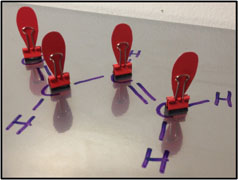by Jordan Axelson, Chemistry
Teaching Effectiveness Award Essay, 2014
Chemists have developed various types of representations to visualize the miniscule structures and rationalize the reactivities of the substances that they study. Because these representations provide valuable insight into the invisible world of molecules, they are essential to the teaching and learning of chemistry. A Lewis structure is one of the most common diagrams used to depict the structure of a molecule by designating each atom with letters and the bonds between atoms as lines. In certain cases, multiple logical Lewis structures can be drawn to illustrate a single molecule by “pushing” the bonds back and forth between different sets of atoms. In such instances, it is the superposition of all “resonance structures” that embodies the true structure of the molecule. Although resonance is introduced in General Chemistry to describe structure, in Organic Chemistry it serves as an indicator of electron delocalization, a characteristic that influences the molecule’s reactivity and chemical behavior. During 2012, I served as head GSI for both first and second semesters of organic chemistry (Chemistry 3A and 3B). Despite the utility of resonance in solving problems presented during these classes, I found that at the end of Chem 3B, many students still struggled to understand and apply resonance.
Consequently, in the spring of 2013, I took Designed Based Research (Education 290C) with Professor Dor Abrahamson and chose to investigate this problem as my semester-long research project. During my preliminary literature search, I came to learn about the differences of implicit and explicit features of representations. (Implicit features are underlying characteristics not directly expressed or revealed, whereas explicit features are quite obviously experienced by the senses.) In order to help students better understand resonance, I chose to create an activity that drew attention to the locations of a molecule’s p-orbitals, an implicit feature of Lewis structures that can also be used to signify electron delocalization. Lewis structures and resonance emphasize a two-dimensional perspective of the molecule, but incorporating orbitals requires the consideration of the three-dimensional spatial orientation of the atoms, bonds, and p-orbitals. Because another stumbling block encountered by students in chemistry is the translation between different diagrammatic representations of molecules, I hypothesized that the direct conversion between a Lewis structure and a three-dimensional depiction might in itself be a barrier to learning.

To alleviate this challenge, I built a kit that included a stainless steel “whiteboard,” dry-erase markers, and colored magnetic pieces meant to represent a single lobe of a p-orbital. The familiar Lewis structure could first be drawn on the board. The orbital pieces could then be placed over the appropriate atoms to designate the location of the p-orbitals. The reflective quality of the board permitted the other half of the p- orbital to manifest. Because the orbital pieces could be directly added to a Lewis structure, the resulting representation was rendered topologically isomorphic to the corresponding resonance structures.
To test the efficacy of this activity, I performed four videotaped interviews with undergraduate students who were currently enrolled in Chem 3A or Chem 3B at UC Berkeley. The reception of the orbital pieces was positive, and during a brief quiz at the end of the activity, all students were able to use the kit to identify where electron delocalization occurred within a molecule. However, when asked to extend this knowledge to questions about the molecule’s reactivity, results varied. From post analysis of the videos, it seemed that the extent to which students succeeded or struggled with this component depended on their awareness of a second implicit feature of Lewis diagrams, the electronegativity of the atoms. (Electronegativity is the tendency of an atom to attract shared electrons to itself.) Overall, I felt that the kit and activity were successful in some respects but that more development is required to enhance it. However, the most important thing I learned is that emphasizing implicit features in general can greatly aid chemistry students in their quest for understanding and problem solving.

